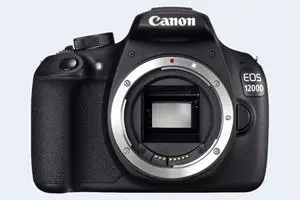Olympus E-PM1 vs Canon 1200D
The Olympus PEN E-PM1 and the Canon EOS 1200D (labelled Canon T5 in some countries) are two digital cameras that were announced, respectively, in June 2011 and February 2014. The E-PM1 is a mirrorless interchangeable lens camera, while the 1200D is a DSLR. The cameras are based on a Four Thirds (E-PM1) and an APS-C (1200D) sensor. The Olympus has a resolution of 12.2 megapixels, whereas the Canon provides 17.9 MP.
Below is an overview of the main specs of the two cameras as a starting point for the comparison.

Check E-PM1 offers at
ebay.com

Check 1200D offers at
ebay.com
Going beyond this snapshot of core features and characteristics, what are the differences between the Olympus PEN E-PM1 and the Canon EOS 1200D? Which one should you buy? Read on to find out how these two cameras compare with respect to their body size, their imaging sensors, their shooting features, their input-output connections, and their reception by expert reviewers.
Body comparison
The side-by-side display below illustrates the physical size and weight of the Olympus E-PM1 and the Canon 1200D. The two cameras are presented according to their relative size. Three consecutive perspectives from the front, the top, and the back are available. All width, height and depth measures are rounded to the nearest millimeter.
The E-PM1 can be obtained in six different colors (black, silver, brown, pink, purple, white), while the 1200D is only available in black.
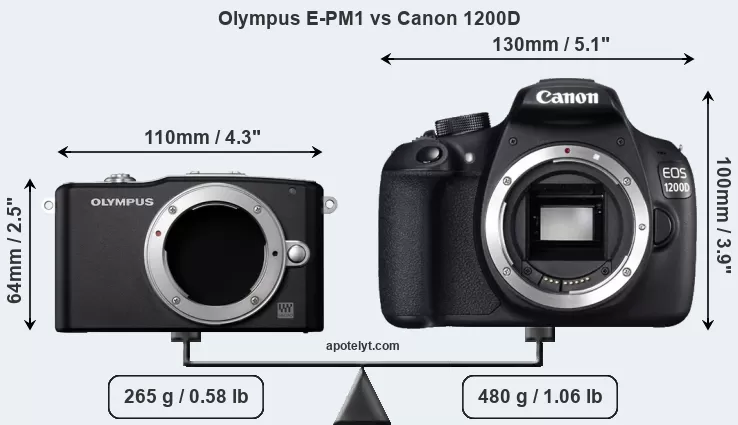
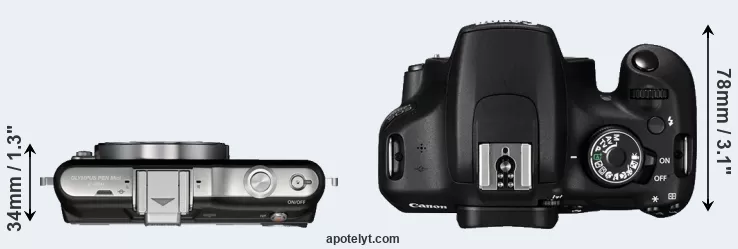
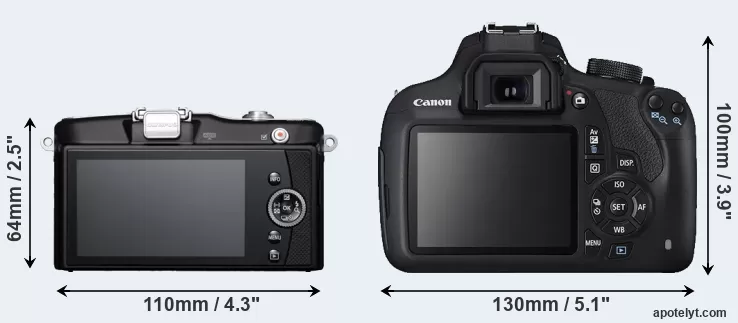
If the front view area (width x height) of the cameras is taken as an aggregate measure of their size, the Canon 1200D is considerably larger (85 percent) than the Olympus E-PM1. Moreover, the 1200D is substantially heavier (81 percent) than the E-PM1. In this context, it is worth noting that neither the E-PM1 nor the 1200D are weather-sealed.
The above size and weight comparisons are to some extent incomplete since they do not consider the interchangeable lenses that both of these cameras require. A larger imaging sensor will tend to go along with bigger and heavier lenses, although exceptions exist. You can compare the optics available for the two cameras in the Micro Four Thirds Lens Catalog (E-PM1) and the Canon EF Lens Catalog (1200D). Mirrorless cameras, such as the Olympus E-PM1, have moreover the advantage that they have a relatively short flange to focal plane distance and can thus use many lenses from other systems via adapters.
Concerning battery life, the E-PM1 gets 330 shots out of its Olympus BLS-5 battery, while the 1200D can take 500 images on a single charge of its Canon LP-E10 power pack.
The table below summarizes the key physical specs of the two cameras alongside a broader set of comparators. If you want to switch the focus of the display and review another camera pair, you can move across to the CAM-parator tool and choose from the broad selection of possible camera comparisons there.

| Camera Model |
Camera Width |
Camera Height |
Camera Depth |
Camera Weight |
Battery Life |
Weather Sealing |
Camera Launch |
Launch Price |
Street Price |
||
|---|---|---|---|---|---|---|---|---|---|---|---|
| 1. | Olympus E-PM1 | 110 mm | 64 mm | 34 mm | 265 g | 330 | n | Jun 2011 | US$ 499 | ebay.com | |
| 2. | Canon 1200D | 130 mm | 100 mm | 78 mm | 480 g | 500 | n | Feb 2014 | US$ 449 | ebay.com | |
| 3. | Canon 100D | 117 mm | 91 mm | 69 mm | 407 g | 380 | n | Mar 2013 | US$ 549 | ebay.com | |
| 4. | Canon 700D | 133 mm | 100 mm | 79 mm | 580 g | 440 | n | Mar 2013 | US$ 649 | ebay.com | |
| 5. | Canon 1100D | 130 mm | 100 mm | 78 mm | 495 g | 700 | n | Feb 2011 | US$ 449 | ebay.com | |
| 6. | Canon 1300D | 129 mm | 101 mm | 78 mm | 485 g | 500 | n | Mar 2016 | US$ 449 | ebay.com | |
| 7. | Canon 4000D | 129 mm | 102 mm | 77 mm | 436 g | 500 | n | Feb 2018 | US$ 399 | amazon.com | |
| 8. | Olympus E-P3 | 122 mm | 69 mm | 34 mm | 369 g | 330 | n | Jun 2011 | US$ 799 | ebay.com | |
| 9. | Olympus E-PL1 | 115 mm | 72 mm | 42 mm | 334 g | 290 | n | Feb 2010 | US$ 599 | ebay.com | |
| 10. | Olympus E-PL2 | 114 mm | 72 mm | 42 mm | 362 g | 280 | n | Jan 2011 | US$ 599 | ebay.com | |
| 11. | Olympus E-PL3 | 110 mm | 64 mm | 37 mm | 313 g | 300 | n | Jun 2011 | US$ 599 | ebay.com | |
| 12. | Olympus E-PL5 | 111 mm | 64 mm | 38 mm | 325 g | 360 | n | Sep 2012 | US$ 599 | ebay.com | |
| 13. | Olympus E-PM2 | 110 mm | 64 mm | 34 mm | 269 g | 360 | n | Sep 2012 | US$ 499 | ebay.com | |
| 14. | Panasonic G2 | 124 mm | 84 mm | 74 mm | 428 g | 360 | n | Mar 2010 | US$ 599 | ebay.com | |
| 15. | Panasonic GF2 | 113 mm | 68 mm | 33 mm | 310 g | 300 | n | Nov 2010 | US$ 549 | ebay.com | |
| 16. | Panasonic GF3 | 108 mm | 67 mm | 32 mm | 264 g | 300 | n | Jun 2011 | US$ 549 | ebay.com | |
| 17. | Panasonic GF5 | 108 mm | 67 mm | 37 mm | 267 g | 360 | n | Apr 2012 | US$ 499 | ebay.com | |
| Note: Measurements and pricing do not include easily detachable parts, such as add-on or interchangeable lenses or optional viewfinders. | |||||||||||
The price is, of course, an important factor in any camera decision. The listed launch prices provide an indication of the market segment that the manufacturer of the cameras have been targeting. The 1200D was somewhat cheaper (by 10 percent) than the E-PM1 at launch, but both cameras fall into the same price category. Usually, retail prices stay at first close to the launch price, but after several months, discounts become available. Later in the product cycle and, in particular, when the replacement model is about to appear, further discounting and stock clearance sales often push the camera price considerably down. Then, after the new model is out, very good deals can frequently be found on the pre-owned market.
Sensor comparison
The size of the sensor inside a digital camera is one of the key determinants of image quality. All other things equal, a large sensor will have larger individual pixel-units that offer better low-light sensitivity, wider dynamic range, and richer color-depth than smaller pixels in a sensor of the same technological generation. Furthermore, a large sensor camera will give the photographer more possibilities to use shallow depth-of-field in order to isolate a subject from the background. On the downside, larger sensors are more costly to manufacture and tend to lead to bigger and heavier cameras and lenses.
Of the two cameras under consideration, the Olympus E-PM1 features a Four Thirds sensor and the Canon 1200D an APS-C sensor. The sensor area in the 1200D is 48 percent bigger. As a result of these sensor size differences, the cameras have a format factor of, respectively, 2.0 and 1.6. The sensor in the E-PM1 has a native 4:3 aspect ratio, while the one in the 1200D offers a 3:2 aspect.
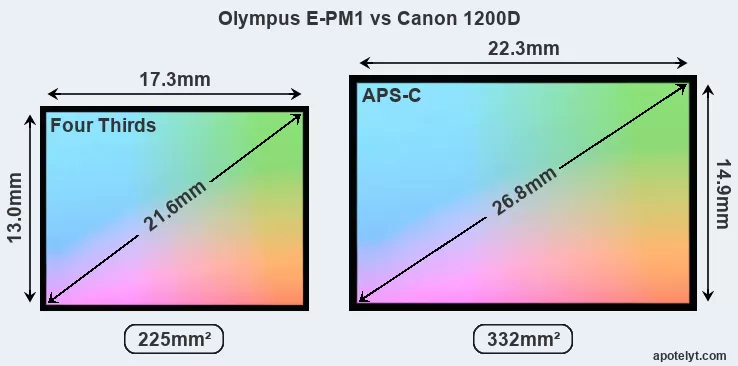
With 17.9MP, the 1200D offers a higher resolution than the E-PM1 (12.2MP), but the 1200D nevertheless has marginally larger individual pixels (pixel pitch of 4.31μm versus 4.29μm for the E-PM1) due to its larger sensor. Moreover, the 1200D is a much more recent model (by 2 years and 7 months) than the E-PM1, and its sensor will have benefitted from technological advances during this time that further enhance the light gathering capacity of its pixel-units.
The resolution advantage of the Canon 1200D implies greater flexibility for cropping images or the possibility to print larger pictures. The maximum print size of the 1200D for good quality output (200 dots per inch) amounts to 25.9 x 17.3 inches or 65.8 x 43.9 cm, for very good quality (250 dpi) 20.7 x 13.8 inches or 52.7 x 35.1 cm, and for excellent quality (300 dpi) 17.3 x 11.5 inches or 43.9 x 29.3 cm. The corresponding values for the Olympus E-PM1 are 20.2 x 15.1 inches or 51.2 x 38.4 cm for good quality, 16.1 x 12.1 inches or 41 x 30.7 cm for very good quality, and 13.4 x 10.1 inches or 34.1 x 25.6 cm for excellent quality prints.
The Olympus PEN E-PM1 has a native sensitivity range from ISO 100 to ISO 12800. The corresponding ISO settings for the Canon EOS 1200D are ISO 100 to ISO 6400, with the possibility to increase the ISO range to 100-12800.
Technology-wise, both cameras are equipped with CMOS (Complementary Metal–Oxide–Semiconductor) sensors. Both cameras use a Bayer filter for capturing RGB colors on a square grid of photosensors. This arrangement is found in most digital cameras.
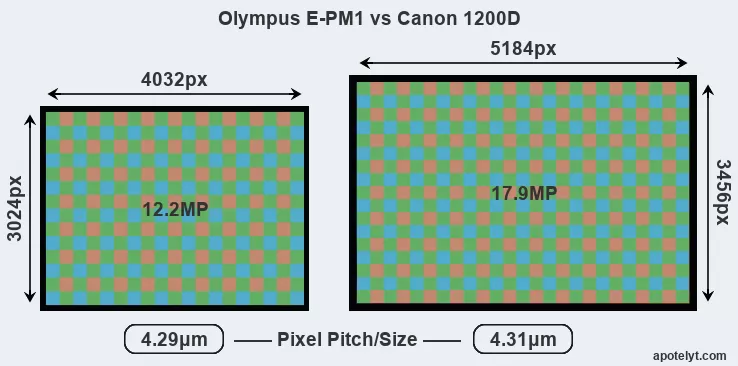
Consistent information on actual sensor performance is available from DXO Mark for many cameras. This service assesses and scores the color depth ("DXO Portrait"), dynamic range ("DXO Landscape"), and low-light sensitivity ("DXO Sports") of camera sensors, and also publishes an overall camera score. Of the two cameras under consideration, the 1200D offers substantially better image quality than the E-PM1 (overall score 11 points higher). The advantage is based on 0.9 bits higher color depth, 1 EV in additional dynamic range, and 0.5 stops in additional low light sensitivity. The table below summarizes the physical sensor characteristics and sensor quality findings and compares them across a set of similar cameras.

| Camera Model |
Sensor Class |
Resolution (MP) |
Horiz. Pixels |
Vert. Pixels |
Video Format |
DXO Portrait |
DXO Landscape |
DXO Sports |
DXO Overall |
||
|---|---|---|---|---|---|---|---|---|---|---|---|
| 1. | Olympus E-PM1 | Four Thirds | 12.2 | 4032 | 3024 | 1080/60i | 21.0 | 10.3 | 499 | 52 | |
| 2. | Canon 1200D | APS-C | 17.9 | 5184 | 3456 | 1080/30p | 21.9 | 11.3 | 724 | 63 | |
| 3. | Canon 100D | APS-C | 17.9 | 5184 | 3456 | 1080/30p | 21.8 | 11.3 | 843 | 63 | |
| 4. | Canon 700D | APS-C | 17.9 | 5184 | 3456 | 1080/30p | 21.7 | 11.2 | 681 | 61 | |
| 5. | Canon 1100D | APS-C | 12.2 | 4272 | 2848 | 720/30p | 21.9 | 11.0 | 755 | 62 | |
| 6. | Canon 1300D | APS-C | 17.9 | 5184 | 3456 | 1080/30p | 22.0 | 11.7 | 781 | 66 | |
| 7. | Canon 4000D | APS-C | 17.9 | 5184 | 3456 | 1080/30p | 21.9 | 11.4 | 695 | 63 | |
| 8. | Olympus E-P3 | Four Thirds | 12.2 | 4032 | 3024 | 1080/60i | 20.8 | 10.1 | 536 | 51 | |
| 9. | Olympus E-PL1 | Four Thirds | 12.2 | 4032 | 3024 | 720/30p | 21.5 | 10.1 | 487 | 54 | |
| 10. | Olympus E-PL2 | Four Thirds | 12.2 | 4032 | 3024 | 720/30p | 21.4 | 10.2 | 573 | 55 | |
| 11. | Olympus E-PL3 | Four Thirds | 12.2 | 4032 | 3024 | 1080/60i | 20.9 | 10.3 | 499 | 52 | |
| 12. | Olympus E-PL5 | Four Thirds | 15.9 | 4608 | 3456 | 1080/30p | 22.8 | 12.3 | 889 | 72 | |
| 13. | Olympus E-PM2 | Four Thirds | 15.9 | 4608 | 3456 | 1080/30p | 22.7 | 12.2 | 932 | 72 | |
| 14. | Panasonic G2 | Four Thirds | 12.0 | 4000 | 3000 | 720/30p | 21.2 | 10.3 | 493 | 53 | |
| 15. | Panasonic GF2 | Four Thirds | 12.0 | 4000 | 3000 | 1080/60i | 21.2 | 10.3 | 506 | 54 | |
| 16. | Panasonic GF3 | Four Thirds | 12.0 | 4000 | 3000 | 1080/60i | 20.6 | 10.1 | 459 | 50 | |
| 17. | Panasonic GF5 | Four Thirds | 12.0 | 4000 | 3000 | 1080/60i | 20.5 | 10.0 | 573 | 50 |
Many modern cameras are not only capable of taking still images, but also of capturing video footage. Both cameras under consideration have a sensor with sufficiently fast read-out times for moving pictures, but the E-PM1 provides a higher frame rate than the 1200D. It can shoot video footage at 1080/60i, while the Canon is limited to 1080/30p.
Feature comparison
Apart from body and sensor, cameras can and do differ across a variety of features. For example, the 1200D has an optical viewfinder, which can be very useful when shooting in bright sunlight. In contrast, the E-PM1 relies on live view and the rear LCD for framing. That said, the E-PM1 can be equipped with an optional viewfinder – the VF-2. The table below summarizes some of the other core capabilities of the Olympus E-PM1 and Canon 1200D in connection with corresponding information for a sample of similar cameras.

| Camera Model |
Viewfinder (Type or 000 dots) |
Control Panel (yes/no) |
LCD Specifications (inch/000 dots) |
LCD Attach- ment |
Touch Screen (yes/no) |
Max Shutter Speed * |
Max Shutter Flaps * |
Built-in Flash (yes/no) |
Built-in Image Stab |
||
|---|---|---|---|---|---|---|---|---|---|---|---|
| 1. | Olympus E-PM1 | optional | n | 3.0 / 460 | fixed | n | 1/4000s | 5.5/s | n | Y | |
| 2. | Canon 1200D | optical | n | 3.0 / 460 | fixed | n | 1/4000s | 3.0/s | Y | n | |
| 3. | Canon 100D | optical | n | 3.0 / 1040 | fixed | Y | 1/4000s | 4.9/s | Y | n | |
| 4. | Canon 700D | optical | n | 3.0 / 1040 | swivel | Y | 1/4000s | 5.0/s | Y | n | |
| 5. | Canon 1100D | optical | n | 2.7 / 230 | fixed | n | 1/4000s | 3.0/s | Y | n | |
| 6. | Canon 1300D | optical | n | 3.0 / 920 | fixed | n | 1/4000s | 3.0/s | Y | n | |
| 7. | Canon 4000D | optical | n | 2.7 / 230 | fixed | n | 1/4000s | 3.0/s | Y | n | |
| 8. | Olympus E-P3 | optional | n | 3.0 / 614 | fixed | Y | 1/4000s | 3.0/s | Y | Y | |
| 9. | Olympus E-PL1 | optional | n | 2.7 / 230 | fixed | n | 1/2000s | 3.0/s | Y | Y | |
| 10. | Olympus E-PL2 | optional | n | 3.0 / 460 | fixed | n | 1/4000s | 3.0/s | Y | Y | |
| 11. | Olympus E-PL3 | optional | n | 3.0 / 460 | tilting | n | 1/4000s | 5.5/s | n | Y | |
| 12. | Olympus E-PL5 | optional | n | 3.0 / 460 | tilting | Y | 1/4000s | 8.0/s | n | Y | |
| 13. | Olympus E-PM2 | optional | n | 3.0 / 460 | fixed | Y | 1/4000s | 8.0/s | n | Y | |
| 14. | Panasonic G2 | 1440 | n | 3.0 / 460 | swivel | Y | 1/4000s | 2.6/s | Y | n | |
| 15. | Panasonic GF2 | optional | n | 3.0 / 460 | fixed | Y | 1/4000s | 2.6/s | Y | n | |
| 16. | Panasonic GF3 | none | n | 3.0 / 460 | fixed | Y | 1/4000s | 3.2/s | Y | n | |
| 17. | Panasonic GF5 | none | n | 3.0 / 920 | fixed | Y | 1/4000s | 4.0/s | Y | n | |
| Note: *) Information refers to the mechanical shutter, unless the camera only has an electronic one. | |||||||||||
One feature that differentiates the E-PM1 and the 1200D is in-body image stabilization (IBIS). The E-PM1 reduces the risk of handshake-induced blur with all attached lenses, while the 1200D offers no blur reduction with lenses that themselves do not provide optical image stabilization.
Concerning the storage of imaging data, both the E-PM1 and the 1200D write their files to SDXC cards.
Connectivity comparison
For some imaging applications, the extent to which a camera can communicate with its environment can be an important aspect in the camera decision process. The table below provides an overview of the connectivity of the Olympus PEN E-PM1 and Canon EOS 1200D and, in particular, the interfaces the cameras (and selected comparators) provide for accessory control and data transfer.

| Camera Model |
Hotshoe Port |
Internal Mic / Speaker |
Microphone Port |
Headphone Port |
HDMI Port |
USB Port |
WiFi Support |
NFC Support |
Bluetooth Support |
||
|---|---|---|---|---|---|---|---|---|---|---|---|
| 1. | Olympus E-PM1 | Y | stereo / mono | - | - | mini | 2.0 | - | - | - | |
| 2. | Canon 1200D | Y | mono / mono | - | - | mini | 2.0 | - | - | - | |
| 3. | Canon 100D | Y | mono / mono | Y | - | mini | 2.0 | - | - | - | |
| 4. | Canon 700D | Y | stereo / mono | Y | - | mini | 2.0 | - | - | - | |
| 5. | Canon 1100D | Y | stereo / mono | - | - | mini | 2.0 | - | - | - | |
| 6. | Canon 1300D | Y | mono / mono | - | - | mini | 2.0 | Y | Y | - | |
| 7. | Canon 4000D | Y | mono / mono | - | - | mini | 2.0 | Y | Y | - | |
| 8. | Olympus E-P3 | Y | stereo / - | - | - | mini | 2.0 | - | - | - | |
| 9. | Olympus E-PL1 | Y | stereo / - | - | - | mini | 2.0 | - | - | - | |
| 10. | Olympus E-PL2 | Y | stereo / - | - | - | mini | 2.0 | - | - | - | |
| 11. | Olympus E-PL3 | Y | stereo / - | - | - | mini | 2.0 | - | - | - | |
| 12. | Olympus E-PL5 | Y | stereo / mono | - | - | mini | 2.0 | - | - | - | |
| 13. | Olympus E-PM2 | Y | stereo / mono | - | - | mini | 2.0 | - | - | - | |
| 14. | Panasonic G2 | Y | stereo / mono | - | - | mini | 2.0 | - | - | - | |
| 15. | Panasonic GF2 | Y | stereo / mono | - | - | mini | 2.0 | - | - | - | |
| 16. | Panasonic GF3 | - | stereo / mono | - | - | mini | 2.0 | - | - | - | |
| 17. | Panasonic GF5 | - | stereo / mono | - | - | mini | 2.0 | - | - | - |
Both the E-PM1 and the 1200D have been discontinued, but can regularly be found used on ebay. The E-PM1 was replaced by the Olympus E-PM2, while the 1200D was followed by the Canon 1300D. Further information on the features and operation of the E-PM1 and 1200D can be found, respectively, in the Olympus E-PM1 Manual (free pdf) or the online Canon 1200D Manual.
Review summary
So what is the bottom line? Which of the two cameras – the Olympus E-PM1 or the Canon 1200D – has the upper hand? Is one clearly better than the other? Below is a summary of the relative strengths of each of the two contestants.

Advantages of the Olympus PEN E-PM1:
- Better video: Provides higher movie framerates (1080/60i versus 1080/30p).
- Faster burst: Shoots at higher frequency (5.5 vs 3 flaps/sec) to capture the decisive moment.
- More compact: Is smaller (110x64mm vs 130x100mm) and thus needs less room in the bag.
- Less heavy: Is lighter (by 215g or 45 percent) and hence easier to carry around.
- Sharper images: Has hand-shake reducing image stabilization built-in.
- More legacy lens friendly: Can take a broad range of non-native lenses via adapters.
- More heavily discounted: Has been available for much longer (launched in June 2011).

Reasons to prefer the Canon EOS 1200D:
- More detail: Has more megapixels (17.9 vs 12.2MP), which boosts linear resolution by 24%.
- Better image quality: Scores substantially higher (11 points) in the DXO overall evaluation.
- More dynamic range: Captures a broader range of light and dark details (1 EV of extra DR).
- Better low-light sensitivity: Can shoot in dim conditions (0.5 stops ISO advantage).
- Easier framing: Has an optical viewfinder for image composition and settings control.
- Longer lasting: Gets more shots (500 versus 330) out of a single battery charge.
- Easier fill-in: Has a small integrated flash to brighten shadows of backlit subjects.
- More modern: Reflects 2 years and 7 months of technical progress since the E-PM1 launch.
If the count of individual advantages (bullet points above) is taken as a guide, the 1200D comes out slightly ahead of the E-PM1 (8 : 7 points). However, the relative importance of the various individual camera aspects will vary according to personal preferences and needs, so that you might like to apply corresponding weights to the particular features before making a decision on a new camera. A professional sports photographer will view the differences between cameras in a way that diverges from the perspective of a street photog, and a person interested in family portraits has distinct needs from a landscape shooter. Hence, the decision which camera is best and worth buying is often a very personal one.
How about other alternatives? Do the specifications of the Olympus E-PM1 and the Canon 1200D place the cameras among the top in their class? Find out in the latest Best Mirrorless Interchangeable Lens Camera and Best DSLR Camera listings whether the two cameras rank among the cream of the crop.
In any case, while the comparison of technical specifications can provide a useful overview of the capabilities of different cameras, it remains partial and cannot reveal, for example, the shooting experience and imaging performance when actually working with the E-PM1 or the 1200D. User reviews, such as those found at amazon, can sometimes inform about these issues, but such feedback is often incomplete, inconsistent, and biased.
Expert reviews
This is why expert reviews are important. The following table reports the overall ratings of the cameras as published by some of the major camera review sites (amateurphotographer [AP], cameralabs [CL], digitalcameraworld [DCW], dpreview [DPR], ephotozine [EPZ], photographyblog [PB]). As can be seen, the professional reviewers agree in many cases on the quality of different cameras, but sometimes their assessments diverge, reinforcing the earlier point that a camera decision is often a very personal choice.

| Camera Model |
AP score |
CL score |
DCW score |
DPR score |
EPZ score |
PB score |
Camera Launch |
Launch Price |
Street Price |
||
|---|---|---|---|---|---|---|---|---|---|---|---|
| 1. | Olympus E-PM1 | .. | 86/100 | .. | 71/100 | 4.5/5 | 4.5/5 | Jun 2011 | US$ 499 | ebay.com | |
| 2. | Canon 1200D | 3/5 | + | .. | .. | 4/5 | 4.5/5 | Feb 2014 | US$ 449 | ebay.com | |
| 3. | Canon 100D | 4/5 | + | .. | 78/100 | 4/5 | 4/5 | Mar 2013 | US$ 549 | ebay.com | |
| 4. | Canon 700D | .. | .. | .. | 76/100 | 4.5/5 | 4.5/5 | Mar 2013 | US$ 649 | ebay.com | |
| 5. | Canon 1100D | .. | 80/100 | .. | 69/100 | 4/5 | 4.5/5 | Feb 2011 | US$ 449 | ebay.com | |
| 6. | Canon 1300D | 4/5 | o | 4/5 | 73/100 | 4/5 | 4/5 | Mar 2016 | US$ 449 | ebay.com | |
| 7. | Canon 4000D | 2.5/5 | o | 3/5 | .. | 3.5/5 | 3.5/5 | Feb 2018 | US$ 399 | amazon.com | |
| 8. | Olympus E-P3 | .. | 83/100 | .. | 74/100 | 4.5/5 | 4.5/5 | Jun 2011 | US$ 799 | ebay.com | |
| 9. | Olympus E-PL1 | .. | 86/100 | .. | 69/100 | 4/5 | 4.5/5 | Feb 2010 | US$ 599 | ebay.com | |
| 10. | Olympus E-PL2 | 3/5 | 83/100 | .. | 71/100 | 4.5/5 | 4.5/5 | Jan 2011 | US$ 599 | ebay.com | |
| 11. | Olympus E-PL3 | 3/5 | + + | .. | 72/100 | 4.5/5 | 4/5 | Jun 2011 | US$ 599 | ebay.com | |
| 12. | Olympus E-PL5 | 3/5 | + + | .. | .. | 4.5/5 | 4.5/5 | Sep 2012 | US$ 599 | ebay.com | |
| 13. | Olympus E-PM2 | 3/5 | .. | .. | 77/100 | 5/5 | 4.5/5 | Sep 2012 | US$ 499 | ebay.com | |
| 14. | Panasonic G2 | .. | .. | .. | 72/100 | 4/5 | 4.5/5 | Mar 2010 | US$ 599 | ebay.com | |
| 15. | Panasonic GF2 | 3/5 | 82/100 | .. | 70/100 | 4.5/5 | 4.5/5 | Nov 2010 | US$ 549 | ebay.com | |
| 16. | Panasonic GF3 | 3/5 | 82/100 | .. | 71/100 | 4.5/5 | 4/5 | Jun 2011 | US$ 549 | ebay.com | |
| 17. | Panasonic GF5 | 3/5 | .. | .. | .. | 4.5/5 | 4.5/5 | Apr 2012 | US$ 499 | ebay.com | |
| Note: (+ +) highly recommended; (+) recommended; (o) reviewed; (..) not available. | |||||||||||
The above review scores should be interpreted with care, though. The ratings were established in reference to similarly priced cameras that were available in the market at the time of the review. Hence, a score should always be seen in the context of the camera's market launch date and its price, and comparisons of ratings among very different cameras or across long time periods have little meaning. Also, please note that some of the review sites have changed their methodology and reporting over time.

Check E-PM1 offers at
ebay.com

Check 1200D offers at
ebay.com
Other camera comparisons
Did this review help to inform your camera decision process? In case you are interested in seeing how other cameras pair up, just make a corresponding selection in the search boxes below. There is also a set of direct links to comparison reviews that other users of the CAM-parator app explored.
- Canon 1200D vs Canon 700D
- Canon 1200D vs Canon R10
- Canon 1200D vs Canon S120
- Canon 1200D vs Leica X2
- Canon 1200D vs Ricoh GR
- Canon 1200D vs Sony H300
- Canon M vs Olympus E-PM1
- Nikon D5500 vs Olympus E-PM1
- Olympus E-PM1 vs Panasonic FT7
- Olympus E-PM1 vs Panasonic G7
- Olympus E-PM1 vs Sony A6500
- Olympus E-PM1 vs Sony A6600
Specifications: Olympus E-PM1 vs Canon 1200D
Below is a side-by-side comparison of the specs of the two cameras to facilitate a quick review of their differences and common features.
| Camera Model | Olympus E-PM1 | Canon 1200D |
|---|---|---|
| Camera Type | Mirrorless system camera | Digital single lens reflex |
| Camera Lens | Micro Four Thirds lenses | Canon EF mount lenses |
| Launch Date | June 2011 | February 2014 |
| Launch Price | USD 499 | USD 449 |
| Sensor Specs | Olympus E-PM1 | Canon 1200D |
| Sensor Technology | CMOS | CMOS |
| Sensor Format | Four Thirds Sensor | APS-C Sensor |
| Sensor Size | 17.3 x 13.0 mm | 22.3 x 14.9 mm |
| Sensor Area | 224.9 mm2 | 332.27 mm2 |
| Sensor Diagonal | 21.6 mm | 26.8 mm |
| Crop Factor | 2.0x | 1.6x |
| Sensor Resolution | 12.2 Megapixels | 17.9 Megapixels |
| Image Resolution | 4032 x 3024 pixels | 5184 x 3456 pixels |
| Pixel Pitch | 4.29 μm | 4.31 μm |
| Pixel Density | 5.42 MP/cm2 | 5.39 MP/cm2 |
| Moiré control | Anti-Alias filter | Anti-Alias filter |
| Movie Capability | 1080/60i Video | 1080/30p Video |
| ISO Setting | 100 - 12,800 ISO | 100 - 6,400 ISO |
| ISO Boost | no Enhancement | 100 - 12,800 ISO |
| Image Processor | TruePic VI | DIGIC 4 |
| DXO Sensor Quality (score) | 52 | 63 |
| DXO Color Depth (bits) | 21.0 | 21.9 |
| DXO Dynamic Range (EV) | 10.3 | 11.3 |
| DXO Low Light (ISO) | 499 | 724 |
| Screen Specs | Olympus E-PM1 | Canon 1200D |
| Viewfinder Type | Viewfinder optional | Optical viewfinder |
| Viewfinder Field of View | 95% | |
| Viewfinder Magnification | 0.50x | |
| LCD Framing | Live View | Live View |
| Rear LCD Size | 3.0inch | 3.0inch |
| LCD Resolution | 460k dots | 460k dots |
| LCD Attachment | Fixed screen | Fixed screen |
| Shooting Specs | Olympus E-PM1 | Canon 1200D |
| Focus System | Contrast-detect AF | Phase-detect AF |
| Continuous Shooting | 5.5 shutter flaps/s | 3 shutter flaps/s |
| Image Stabilization | In-body stabilization | Lens stabilization only |
| Fill Flash | no On-Board Flash | Built-in Flash |
| Storage Medium | SDXC cards | SDXC cards |
| Single or Dual Card Slots | Single card slot | Single card slot |
| UHS card support | no | no |
| Connectivity Specs | Olympus E-PM1 | Canon 1200D |
| External Flash | Hotshoe | Hotshoe |
| USB Connector | USB 2.0 | USB 2.0 |
| HDMI Port | mini HDMI | mini HDMI |
| Wifi Support | no Wifi | no Wifi |
| Body Specs | Olympus E-PM1 | Canon 1200D |
| Battery Type | Olympus BLS-5 | Canon LP-E10 |
| Battery Life (CIPA) | 330 shots per charge | 500 shots per charge |
| Body Dimensions |
110 x 64 x 34 mm (4.3 x 2.5 x 1.3 in) |
130 x 100 x 78 mm (5.1 x 3.9 x 3.1 in) |
| Camera Weight | 265 g (9.3 oz) | 480 g (16.9 oz) |

Check E-PM1 offers at
ebay.com

Check 1200D offers at
ebay.com
Did you notice an error on this page? If so, please get in touch, so that we can correct the information.

